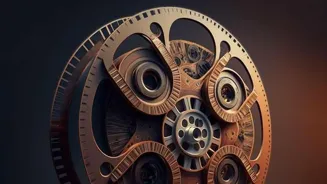Unraveling The Science of Time: From Sundials to Atomic Clocks. Dive into the history and physics behind our timekeeping methods
Time, a concept so fundamental yet so elusive. We measure it, we manage it, and
often, we feel like we're running out of it. But have you ever stopped to think about how we actually know what time it is?

It's all thanks to the fascinating science of timekeeping, a journey through history, physics, and ingenious inventions. From ancient sundials to atomic clocks, the quest to accurately measure time has driven innovation for centuries.
So, let's take a deep dive into the world of clocks and explore the science that keeps us on schedule. In ancient times, humans followed the sun and stars to understand time. Sunrise was the beginning of the day, and sunset marked its end.
People used shadows from sticks or stones to create sundials. They also observed the moon and its cycle to track time as months. These early methods were vital for farming, religious ceremonies, and daily life.
Invention of mechanical clocks revolutionized timekeeping in Europe
The invention of mechanical clocks in Europe during the late Middle Ages was a significant leap forward. These clocks used gears and weights to measure time, making them more accurate than sundials, particularly in cloudy weather.
Then came the pendulum clock in the 17th century, invented by Christiaan Huygens, which greatly improved accuracy. These clocks became status symbols, adorning palaces, town squares and the homes of the wealthy. As timekeeping accuracy improved, so did navigation.
Instruments like the marine chronometer aided sailors finding the precise position while crossing oceans. These clocks worked reliably on ships, no matter how turbulent the seas.
Quartz clocks are precise due to quartz crystal; time is relative in physics
Quartz clocks are far more accurate than pendulum clocks. They use a quartz crystal that vibrates at a precise frequency when electricity passes through it. This consistent frequency is used to measure time, making these clocks very reliable.
Quartz clocks became popular in the mid-20th century and are now found in watches, wall clocks, and many other electronic devices. Now lets understand the basic physics behind time. Time can be considered as sequence of motion of an event. The most commonly understood time is motion of light wave.
In the field of science, time is relative, and it depends on motion. It varies from object to object.
Atomic clocks revolutionize time accuracy, essential in GPS and research
Atomic clocks are the most accurate timekeeping devices we have today. This accuracy is achieved by exploiting atomic properties in precise ways that can’t be obtained with other forms of clock. This is a game changer when it comes to measuring time accurately.
They use the natural resonance frequencies of atoms, such as cesium or rubidium, to measure time with incredible precision. These clocks are so accurate that they lose only about one second every hundreds of millions of years.
Atomic clocks are used in GPS satellites, telecommunications, and scientific research where ultra-precise timing is essential. Without the accuracy of atomic clocks, the GPS system would fail.
Standardization of time zones revolutionized global scheduling, ensuring uniformity and efficiency
The standardization of time zones was a crucial step in organizing our global schedules. Before time zones, each city or region kept its own local time, which could be confusing for travel and communication.
In the late 19th century, time zones were introduced to create standardized regions that shared the same time. We have become a society where time is extremely important. Everything should be within the given schedule. To make things faster we are upgrading our time keeping methods.
For instance, the International Date Line which zigzags across the Pacific Ocean, is an interesting result of this system.
Evolution of time study through quantum physics and technology
Today, the study of time continues to evolve. Scientists are exploring new ways to measure time using quantum physics and advanced technologies. More experiments are being conducted to refine our understanding. Time is very crucial in space missions, like moon missions and space explorations.
Our understanding of time can significantly impact fields like telecommunications, navigation, and fundamental scientific research. As technology advances, our ability to measure time with even greater accuracy will unlock new possibilities and deepen our understanding of the universe.
Lets respect the science and use it wisely.
AI Generated Content. Glance/InMobi shall have no liability for the content











